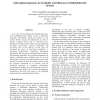372 search results - page 61 / 75 » Power Save Mechanisms for Multi-Hop Wireless Networks |
IPPS
2005
IEEE
14 years 2 months ago
2005
IEEE
We investigate the problem of maximizing the lifetime of wireless ad hoc and sensor networks. Being battery powered, nodes in such networks have to perform their intended task und...
ICDCSW
2002
IEEE
14 years 1 months ago
2002
IEEE
A key issue when designing and implementing largescale publish/subscribe systems is how to efficiently propagate subscriptions among the brokers of the system. Brokers require thi...
MOBICOM
2010
ACM
13 years 8 months ago
2010
ACM
Cellular radios consume more power and suffer reduced data rate when the signal is weak. According to our measurements, the communication energy per bit can be as much as 6x highe...
CDC
2010
IEEE
13 years 3 months ago
2010
IEEE
The communication protocol IEEE 802.15.4 is becoming pervasive for low power and low data rate wireless sensor networks (WSNs) applications, including control and automation. Never...
MASS
2010
13 years 6 months ago
2010
Wireless sensor networks typically conserve energy by following a periodic wakeup-sleep schedule: nodes minimize idle time and spend most of their time in a low power sleep state. ...

